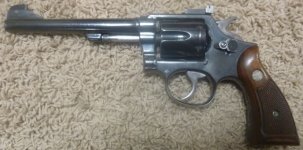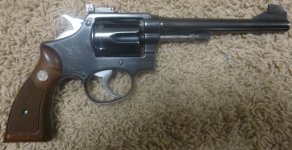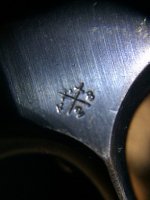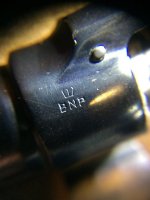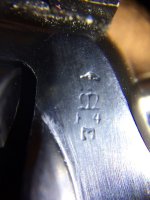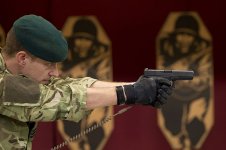Hello from Canada! I've had this pistol in my collection for many years and would love to know more about its history as it has some interesting markings.
It is a Smith and Wesson .38 Special, 6 inch tapered barrel. 4 screw, hand ejector. Post-factory adjustable front and rear sights. I acquired this in the late 90s and was told at the time by the seller that it was a former RCMP service revolver however it does not have a M&P frame stamp and lacks a lanyard swivel. I have also been told it could be an ex WWII British service revolver.
The serial number is listed in three locations on the barrel, cylinder and butt as 681585 all matching, however the left side of the frame under cylinder hinge shows a stamped five digit number 15849. There is no S&W model number anywhere on the revolver. The barrel shows Made in USA on right side, however there are also Birmingham Nitro Proof (BNP) proof marks on it as well as the 4 TONS inscription on barrel and crossed sceptor/sword Birmingham proof house K-B-2 mark between the cylinder and trigger on the left side of the frame.
I have attached the max of five photos showing some of the markings for your reference.
It is a great shooter and functions flawlessly.
Any insight you can offer would be greatly appreciated, and of course estimates on value are a bonus, thanks!!
It is a Smith and Wesson .38 Special, 6 inch tapered barrel. 4 screw, hand ejector. Post-factory adjustable front and rear sights. I acquired this in the late 90s and was told at the time by the seller that it was a former RCMP service revolver however it does not have a M&P frame stamp and lacks a lanyard swivel. I have also been told it could be an ex WWII British service revolver.
The serial number is listed in three locations on the barrel, cylinder and butt as 681585 all matching, however the left side of the frame under cylinder hinge shows a stamped five digit number 15849. There is no S&W model number anywhere on the revolver. The barrel shows Made in USA on right side, however there are also Birmingham Nitro Proof (BNP) proof marks on it as well as the 4 TONS inscription on barrel and crossed sceptor/sword Birmingham proof house K-B-2 mark between the cylinder and trigger on the left side of the frame.
I have attached the max of five photos showing some of the markings for your reference.
It is a great shooter and functions flawlessly.
Any insight you can offer would be greatly appreciated, and of course estimates on value are a bonus, thanks!!

